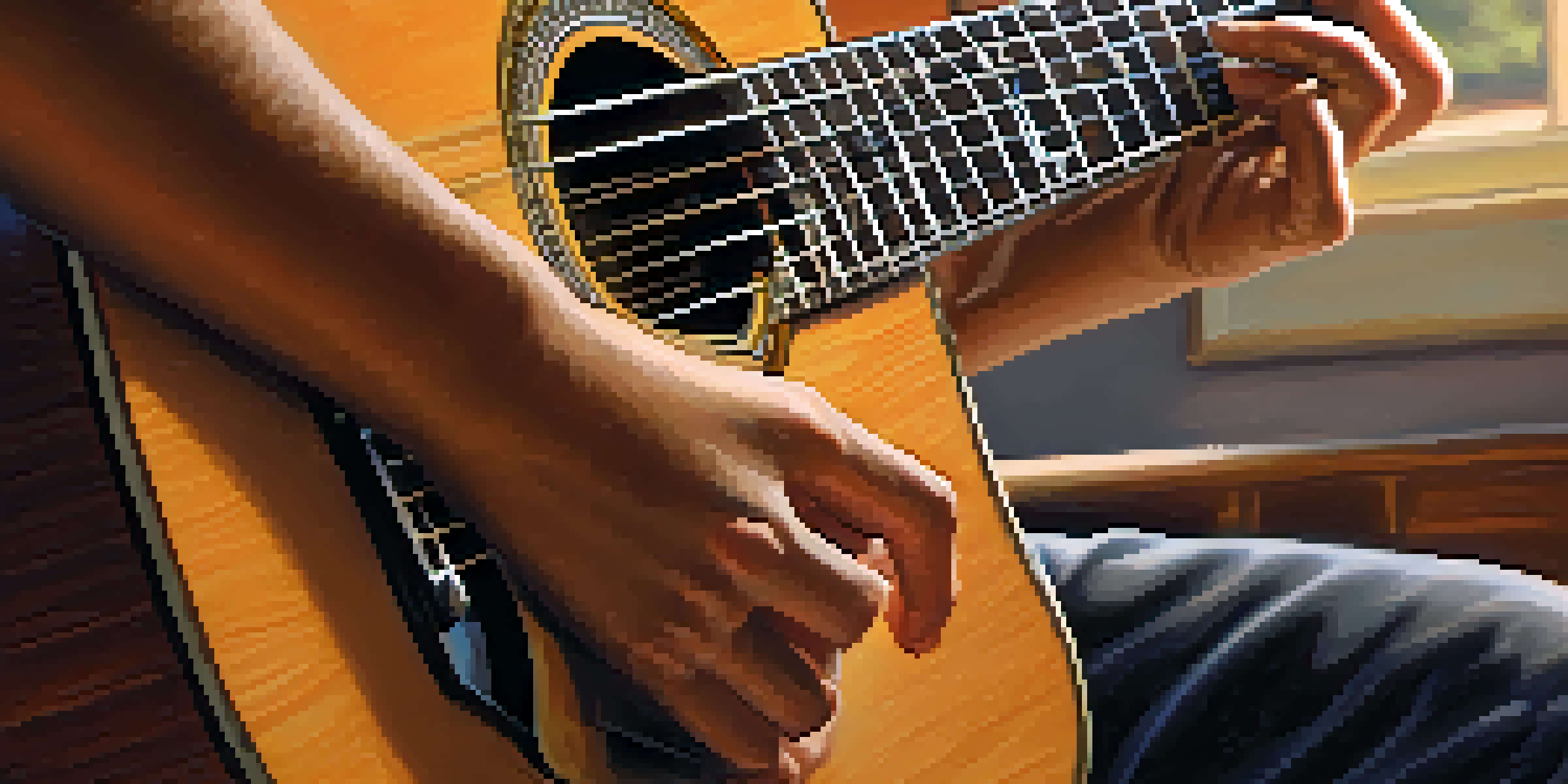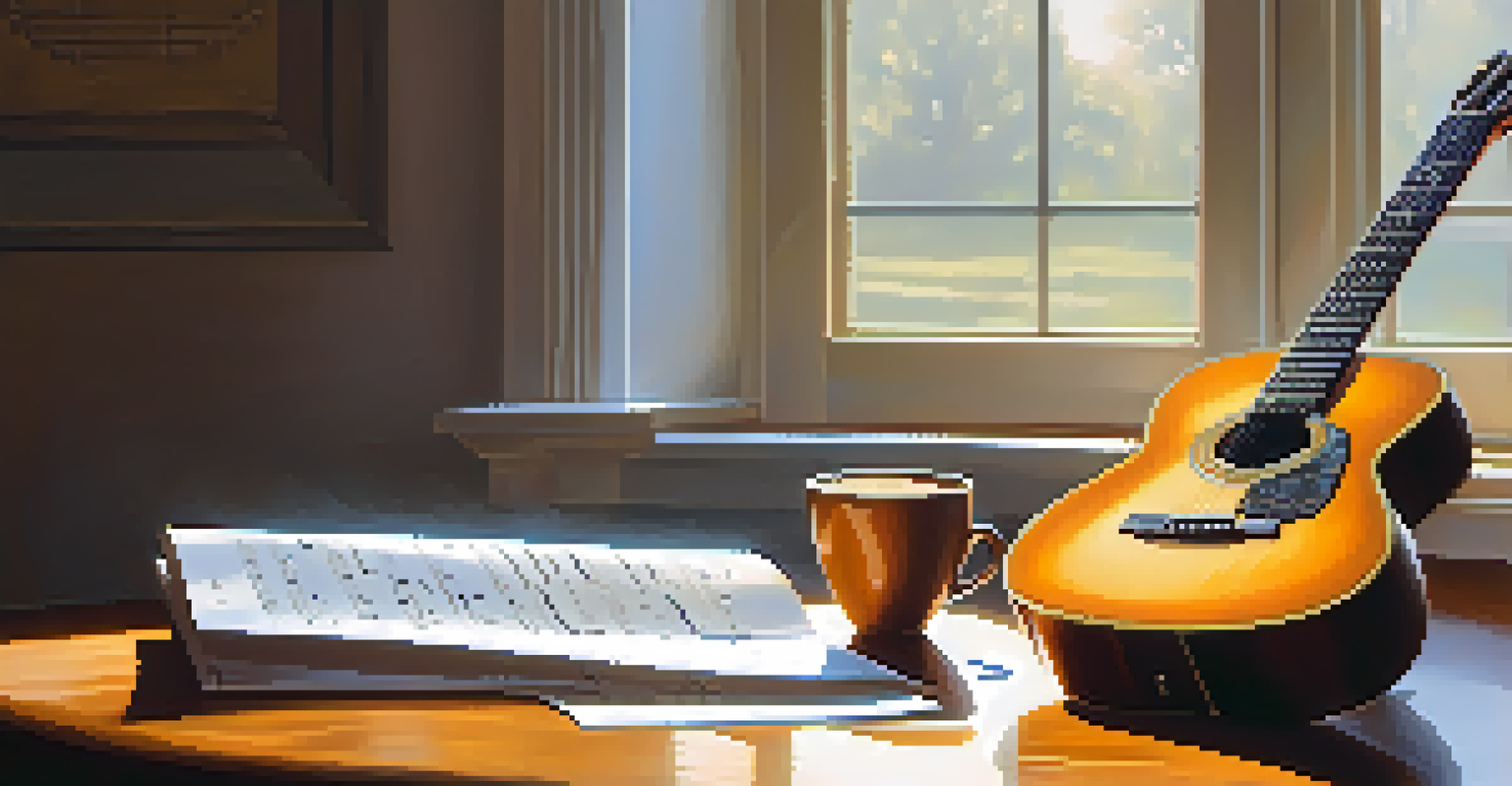Top 10 Fingerstyle Guitar Techniques Every Player Should Master

Understanding Fingerstyle Guitar: A Brief Overview
Fingerstyle guitar is a technique that allows players to pluck the strings directly with their fingers, rather than using a pick. This method not only adds a unique sound but also enables a fuller range of expression within the music. Many famous songs, from folk to classical, benefit from this technique, showcasing its versatility.
Music is the shorthand of emotion.
For beginners, mastering fingerstyle might seem daunting. However, with practice and patience, it can become a natural part of your playing style. Think of it like learning to write with your dominant hand; at first, it feels awkward, but with time, it becomes second nature.
As we delve into the top fingerstyle techniques, remember that each one contributes to your overall sound. Embrace the journey of learning and don’t shy away from experimenting with these techniques to find your unique voice.
1. Basic Finger Placement: The Foundation
Before diving into complex techniques, it's crucial to understand proper finger placement. Typically, the thumb is responsible for the bass notes, while the index, middle, and ring fingers handle melody and harmony. Visualizing this setup can help you navigate the fretboard more effectively.

Start by practicing simple finger patterns on open strings. This will build muscle memory and improve your dexterity. Just like learning to walk before you run, mastering basic placements will set you up for more advanced techniques down the road.
Mastering Fingerstyle Basics
Understanding proper finger placement and practicing simple patterns is essential for developing fingerstyle guitar skills.
Remember, comfort is key. Find a hand position that feels natural to you, as it will enhance your playing experience. Once you have a solid grasp of finger placements, you can move on to more intricate styles.
2. Travis Picking: A Classic Technique
Travis picking is a fingerstyle technique that involves alternating bass notes played by the thumb, while the fingers play melodies. This creates a rich, rhythmic sound that’s perfect for folk and country music. Think of it as a conversation between the bass and melody; they complement each other beautifully.
The beautiful thing about learning is that no one can take it away from you.
To get started, practice the basic pattern slowly. A common Travis picking pattern involves plucking the bass note with your thumb, followed by two melody notes with your index and middle fingers. As you gain confidence, you can speed up and incorporate different chord progressions.
Travis picking not only enhances your fingerstyle repertoire but also improves your timing and coordination. Plus, once you master it, you’ll find that it opens the door to countless songs and styles.
3. Hammer-Ons and Pull-Offs: Adding Expression
Hammer-ons and pull-offs are essential techniques that add flair and expressiveness to your playing. A hammer-on involves using a finger to tap a note on the fretboard, creating a smooth transition between notes. Conversely, a pull-off is the reverse, where you pluck a string and let another finger drop off it.
These techniques can be applied to any song, transforming a simple melody into something more captivating. Practice these techniques slowly, focusing on clarity and precision, as they can significantly enhance the emotional impact of your music.
Combine Techniques for Uniqueness
Blending different fingerstyle techniques allows you to create a distinctive sound that reflects your musical personality.
Think of hammer-ons and pull-offs as the brushstrokes in a painting; they add depth and detail. Once you refine these techniques, you’ll notice a noticeable improvement in your overall sound.
4. Harmonics: Creating Ethereal Sounds
Harmonics are a beautiful way to add an ethereal quality to your fingerstyle guitar. By lightly touching the string at specific fret points while plucking, you produce a bell-like tone. This technique can create atmospheric effects that elevate your music to another level.
To start, practice natural harmonics at the 5th, 7th, and 12th frets. As you get comfortable, experiment with artificial harmonics, which require a bit more finger precision. It may feel tricky at first, but the unique sound is worth the effort.
Incorporating harmonics into your playing can be like adding spices to a dish, enhancing the overall flavor. Once you master this technique, you’ll find endless ways to incorporate it into your songs.
5. Fingerstyle Arpeggios: Building Complexity
Arpeggios involve playing the notes of a chord sequentially rather than all at once. This technique is fundamental to fingerstyle and helps create a flowing sound. Think of it as a gentle waterfall; the notes cascade beautifully, adding complexity to your playing.
To practice arpeggios, start with simple chords and gradually increase the speed and complexity. Focus on clarity, ensuring each note rings out clearly and distinctly. With consistent practice, you’ll find that arpeggios can be integrated seamlessly into your pieces.
Enhance Expression with Techniques
Techniques like hammer-ons, pull-offs, and harmonics add emotional depth and complexity to your fingerstyle playing.
Mastering fingerstyle arpeggios can elevate your guitar skills, allowing you to explore various genres. Once you’ve integrated them into your repertoire, you’ll notice how they enhance both rhythm and melody.
6. Slapping and Popping: Adding Rhythm
Slapping and popping are techniques borrowed from funk and percussive guitar styles. By using your thumb to slap the strings and your fingers to pop them, you create a rhythmic effect that is both dynamic and engaging. This technique can really energize a performance, making it feel alive.
To get started, practice the basics of slapping and popping on open strings. Focus on timing and rhythm, as these techniques are all about creating a groove. Once you’re comfortable, try integrating them into your songs for added flair.

Slapping and popping can be likened to adding percussion to your music; they provide a strong backbeat that complements the melody. Incorporating these techniques will undoubtedly elevate your fingerstyle playing.
7. Alternate Picking: A Versatile Technique
Alternate picking is a technique often used in fingerstyle to create a smooth, consistent sound. This method involves alternating between your fingers—typically your thumb and index finger—for a seamless flow of notes. It’s particularly useful for playing fast passages and intricate melodies.
Start by practicing simple patterns and gradually increase the complexity. Focus on maintaining a steady rhythm, as this will help you develop speed and accuracy. Think of alternate picking as the metronome of your playing; it keeps everything in time.
With practice, alternate picking can become a natural part of your technique. Once you master it, you’ll find it enhances your overall versatility as a player, allowing you to tackle a wider range of musical styles.
8. Combining Techniques: Your Unique Style
The beauty of fingerstyle guitar lies in its versatility; by combining different techniques, you can create a unique sound that reflects your personality. Experiment with layering techniques like hammer-ons, pull-offs, and arpeggios to develop your signature style. This is where your creativity can truly shine.
Start by choosing a few techniques that resonate with you, and practice integrating them into your pieces. You might find that certain combinations create a sound you love. Just like a chef experiments with flavors, your exploration will lead to a richer musical experience.
Embrace the process of blending techniques, as this will not only enhance your playing but also deepen your connection with the music. Over time, you'll develop a style that feels authentic and uniquely yours.